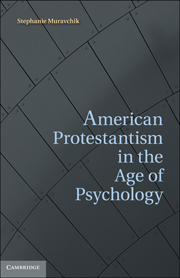Book contents
- Frontmatter
- Contents
- Acknowledgments
- Abbreviations
- 1 The Fall and Rise of Psychoreligious Cooperation
- PART ONE THERAPY AS MINISTRY IN CLINICAL PASTORAL EDUCATION
- PART TWO THERAPY AS FELLOWSHIP IN ALCOHOLICS ANONYMOUS
- PART THREE THERAPY AS EVANGELISM IN THE SALVATION ARMY
- 6 Freud Is Not a Suitable Psychologist
- 7 New Creatures in Christ
- 8 Conclusion: American Psychology in an Age of Faiths
- Bibliography
- Index
- References
6 - Freud Is Not a Suitable Psychologist
from PART THREE - THERAPY AS EVANGELISM IN THE SALVATION ARMY
Published online by Cambridge University Press: 05 July 2011
- Frontmatter
- Contents
- Acknowledgments
- Abbreviations
- 1 The Fall and Rise of Psychoreligious Cooperation
- PART ONE THERAPY AS MINISTRY IN CLINICAL PASTORAL EDUCATION
- PART TWO THERAPY AS FELLOWSHIP IN ALCOHOLICS ANONYMOUS
- PART THREE THERAPY AS EVANGELISM IN THE SALVATION ARMY
- 6 Freud Is Not a Suitable Psychologist
- 7 New Creatures in Christ
- 8 Conclusion: American Psychology in an Age of Faiths
- Bibliography
- Index
- References
Summary
The Salvation Army began in 1865 as a British Protestant evangelical ministry to the urban poor run by the itinerant minister William Booth and his wife, Catherine. Drawing on the military motifs with which some Christians had begun to promote a muscular Christianity, the Booths cast every aspect of their own movement in martial metaphors. The army “opened fire” on the United States in 1880. Their American ministry made early use of informal social service help as a tool of evangelism. The help was practical, not therapeutic. When a few Depression-era Salvationist clergy (called “officers”) began suggesting to their peers that they begin raiding psychology's toolbox, too, they faced great resistance. Opponents held that sin, not pathology, was the root of humankind's troubles.
Nevertheless, the psychological pioneers in the United States eventually won out after World War II. This was due to the fact that their proposals enabled the army to protect itself from the intrusions of an increasingly regulatory federal government. The opponents' fears were not realized, however. The army's independence permitted it – like Alcoholics Anonymous (AA) – to mix a psychoreligious formula uncontaminated by the secularizing atmosphere of public institutions. Furthermore, the fact that it was a church with a strong tradition of hierarchical authority and spiritual leadership meant that it was not as vulnerable to broader cultural currents as AA. Even when brewing psychoreligious admixtures, it reached for many traditional Protestant components.
- Type
- Chapter
- Information
- American Protestantism in the Age of Psychology , pp. 161 - 204Publisher: Cambridge University PressPrint publication year: 2011



